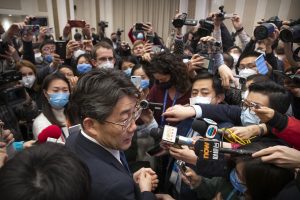As of January 27, the official count of Wuhan coronavirus infections has topped 2,800, with 81 deaths. Many have drawn comparisons between the government response this time and China’s cover-up of its 2003 SARS outbreak, when the Chinese government took four months to disclose the epidemic crisis after its initial discovery. China’s Ministry of Health afterward remarked, “What we learned from SARS is that transparency has a vital impact on whether a crisis is properly handled” and that “any delay in the release of information has a negative influence.”
However, this time again, authorities have failed to report and manage the crisis promptly. The first case of the virus was reported on December 8; it was over a month later, on January 20, that Dr. Zhong Nanshan, the expert leading the crisis management panel, made an official announcement about the outbreak.
The government drew widespread criticism for its delayed response and ineffectiveness in tackling the latest epidemic. International experts have credited China for promptly sharing the genetic sequence of the virus as well as demonstrating greater transparency than during the SARS crisis. However, the failure to contain the virus during the initial stages of the outbreak nevertheless revealed a continuing pattern for China: covering up negative news, for fear of undermining economic growth and destabilizing society.
The main message in the Chinese state media is that the Wuhan municipal government should take the blame for concealing the severity of the virus, and Wuhan’s mayor has acknowledged that initial “warnings were not sufficient.” Yet the central government is not entirely exempt from blame. Online discussions on the outbreak were silenced on December 8, when eight people from Wuhan were reporting a “mysterious virus” that hospitalized many. The trending #WuhanSARS hashtag was closed down on Weibo (a Chinese social media platform similar to Twitter), which is unlikely to have been done at the request of local authorities. And Beijing’s own investigation had reported on January 11 that the situation was under control. According to New York Times, it was only after Hong Kong reported cases of the coronavirus that Beijing acknowledged the outbreak and ceased to downplay the epidemic as a local problem – a chain of events eerily reminiscent of the SARS outbreak.
Given the failed prevention effort and severity of the situation, analysts regard the coronavirus as among the Chinese leadership’s most significant challenges and a credibility crisis for the government. The outbreak alone is, however, unlikely to damage the legitimacy and the credibility of the central government and China’s system.
The media’s narrative has confined the blame to the incompetence of the Wuhan local authorities. Multiple media outlets have criticized the Wuhan government for playing down early warning signs and faulted them for carelessness, such as holding a family banquet for over 40,000 people. In the eyes of the general population, it was the central government, represented by the National Health Commission, that swooped in to take the reins to manage the crisis. While Wuhan authorities made apologies for “insufficient warnings,” Xi Jinping took command to order “all-out efforts” to contain the virus, and a Chinese Communist Party Central Committee task group was set up to oversee disease control. Public criticisms have been directed at Wuhan and Hebei province; online postings calling for Wuhan Mayor Zhou Xianwang’s resignation were left uncensored.
The central government has shown impressive speed in carrying out disease management by bypassing the usual labyrinthine decision-making process and neutralizing the reluctance of interest groups (whether Wuhan citizens or the tourism sector) with centralized authority. Wuhan’s 11 million people were quarantined the day health officials announced that the virus is capable of inter-human transmission. The central authorities also closed down tourism and traffic, and deployed military aid. Two new hospitals were announced, with plans for both to be finished within a week. Premier Li Keqiang appeared at the front line at Wuhan, and state media has accentuated that he was “sent” by Xi. These efforts were amplified by the media and perceived by the population as stemming from the central government’s command.
While some analysts called the scale of the quarantine excessive and note that the isolation has instigated local resentment, its implication for government legitimacy should be assessed at a national scale. A significant number of villages have their entrances barricaded to prevent “outsiders,” and the state media has had to decry signs of public xenophobia against the Hubei population and warn localities not to construct illegal road blockades. It is plausible that the government favors nation-wide approval of its measures over concerns within Hubei province.
So far, the Chinese media has mostly focused on the positives, enforcing the heroic image of Dr. Zhong Nanshan and the front-line medical workers. Frustration or complaints are either censored or directed at local authorities. It is too early to define the outbreak as a legitimacy crisis for the Chinese leadership. Plus, evaluations of government actions will be based on the disastrous response to the 2003 SARS crisis, giving Beijing a relatively low bar to clear.
As China expert Dali Yang has said, if the virus “is stopped it reinforces Xi’s prestige and the impression that China has a system that can act and respond to crisis.”

































